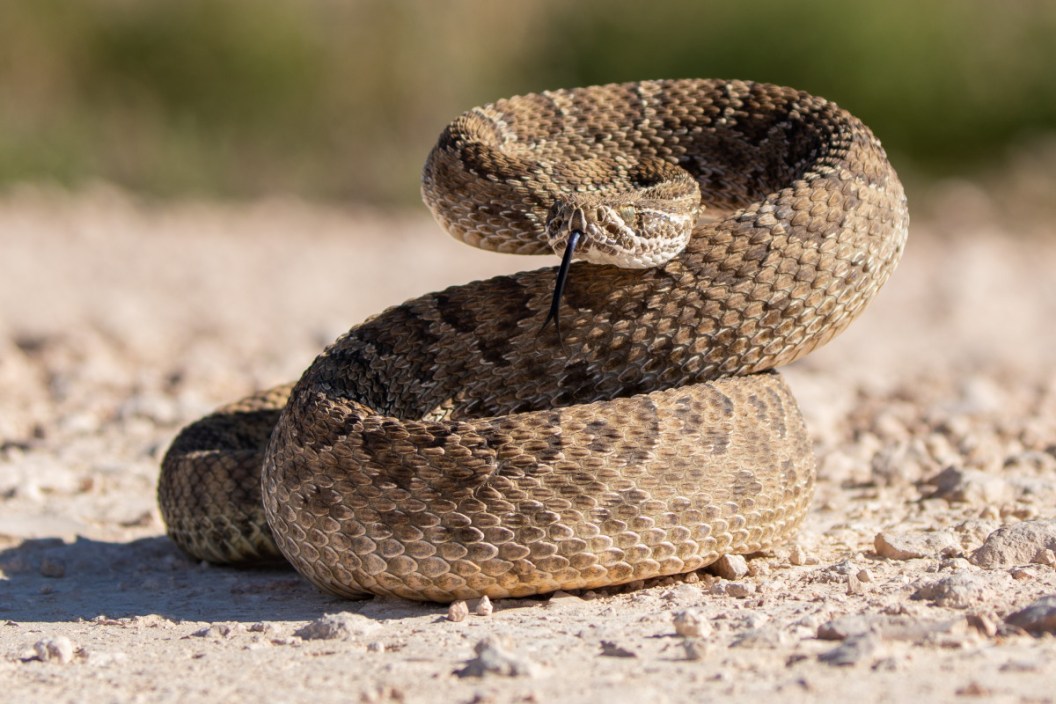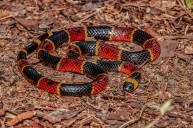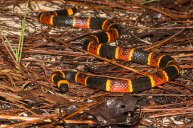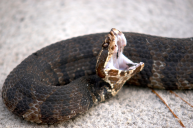It's no secret that many people simply hate snakes regardless of the species. There's something deeply engrained into the psyche of many humans that makes them wary of these limbless serpents that go slithering through our favorite outdoor areas. However, when you step back and look at things, North America has it easy compared to the rest of the world when it comes to snakes that could potentially hurt or kill you. While there's plenty of venomous snakes to go around, for most of us it's not a constant worry every time we step outside. In fact, in many areas the ranges for these snakes do not even overlap, which means in many parts of the United States and Canada, we only need to worry about one or two species at the most.
That is not to say that you should totally let your guard down in the great outdoors. Because there are some species you just do not want to receive a bite from. We're not going to go over every single subspecies because that could take days. Instead, we'll highlight just six main species and subspecies of snake that are of any real concern to human health. Thankfully, avoiding them is easy once you understand just a bit more about their nature and where they like to live.
Copperheads

There are five different subspecies of copperhead snakes (Agistrodon contortrix) living in this continent. Coloration is usually a dark brown or "copper" color, but they can be grey as well. Fortunately, the juvenile snakes are easy to spot due to their bright green or yellow tail tips. The crossbands on their back form an hourglass or platter shape, and their heads are triangular shaped with vertical pupils. Copperheads are pit vipers and they account for more venomous snakebites than any other species currently living in North America. The good news is, their venom isn't nearly as potent as a rattlesnake, so a copperhead bite is seldom fatal. Most fatal copperhead bites stem from the venom expediting other medical conditions the victim suffers from.
Like many snake species, there are a few myths going around about copperheads, namely that younger snakes are somehow more deadly. The crux of this myth seems to hinge on some silly idea that the young snakes cannot control how much venom they are pumping into their victim. We're not sure where that one originated, but we know now these sorts of myths are nothing more than urban legend. However, you still don't want to get bitten by a copperhead, big or small, because treatment is usually based around insanely expensive anti-venom. Many health insurance policies won't cover the full cost either. Copperheads are found mostly in the eastern and southern United States. Their range goes far north to New England states like New York and extends south to North Carolina, South Carolina, across Georgia and to parts of Texas. Strangely enough, they aren't really found in Florida except for a few places in the panhandle.
Timber Rattlesnake
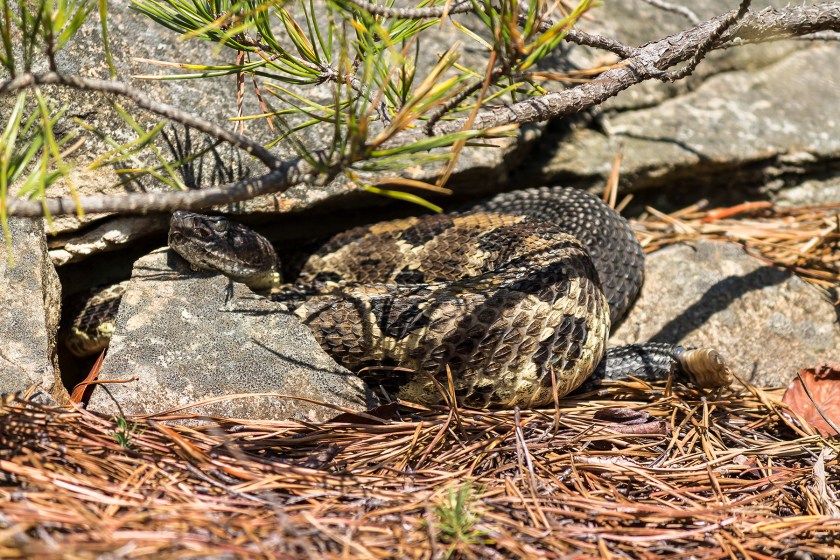
Rattlesnakes are responsible for most deadly bites in North America, especially for pets. Dogs often don't know any better and go sniffing to investigate the sound, ending with a bite. There are a few different subspecies but there is a slightly higher instance of timber rattlesnake bites simply because this one lives in more populous areas than the others. The timber rattlesnake (Crotalus horridus) doesn't grow especially large. Some of the larger specimens can grow to five feet, but that's uncommon. Coloration varies on this species. Most are a yellowish or extremely light brown, but it isn't unusual to see much darker snakes, which can lead to even more confusion and misidentification if someone can't see darker bands or splotches on their backs. Fortunately, like all rattlesnakes, their rattles on the tail are a dead giveaway.
Timber rattlesnakes are most commonly found in Pennsylvania, but they live in pockets all over the eastern United States in places like Massachusetts and New Hampshire. Some have been found in Texas, Florida, Minnesota and Iowa. This species of rattlesnake has been responsible for countless visits to the hospital over the years and many deadly snakebites. A number of these bites were entirely avoidable. Most of them occurred when the victim either attempted to kill or move the animal.
Eastern Diamondback Rattlesnake
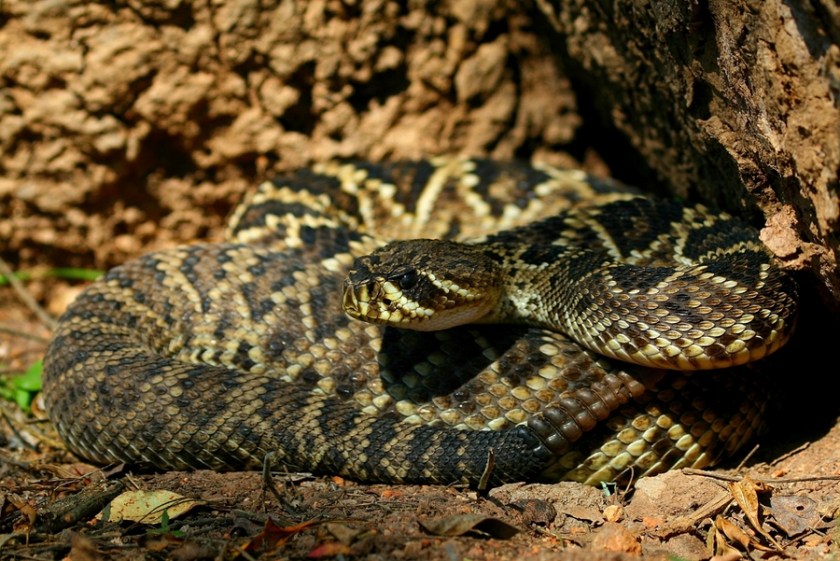
This species (Crotalus adamanteus) is one of the largest snake species in North America, regularly growing over five or six feet in length. It has a very isolated range; it is found throughout Florida with its range extending north into North Carolina and as far west as Louisiana. Coloration for this species again varies. Most are going to be a brown or yellow color with a light-colored belly. Of course, as the name suggests, it has a series of dark blotches or "diamond" shapes going down its back. The tail is tipped with the trademark hollow tail segments that make that distinctive rattle sound that strikes fear in so many humans. If you hear that sound, freeze until you can determine where it came from and if you are in any danger. Trying to run away quickly could trigger the animal into striking.
The eastern diamondback has the unique distinction of being one of the most painful snakebites in North America and it is responsible for many deadly bites over the years. It can be treated with anti-venom, but as we mentioned earlier, it often makes for a hefty hospital bill. That's why we recommend just leaving this species alone when you see it. If you leave this snake alone, it will likely leave you alone too.
Western Diamondback Rattlesnake
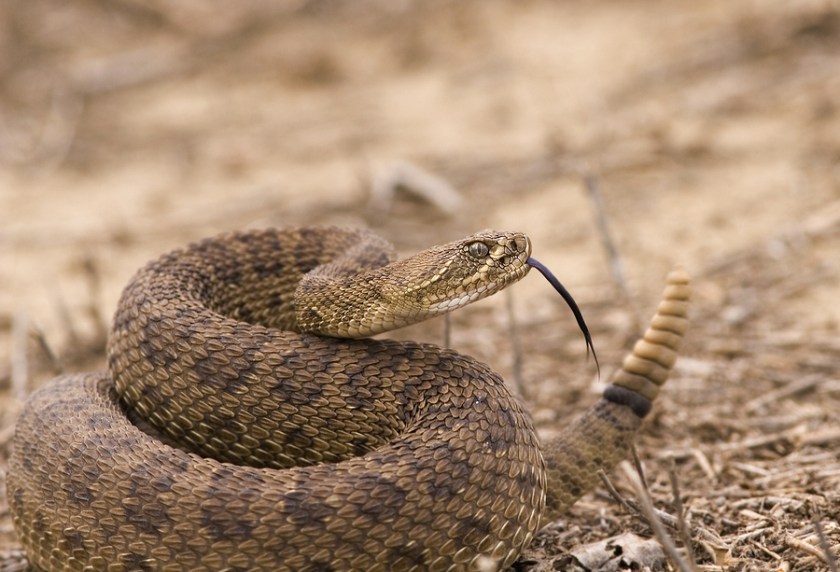
This rattler is probably one of the most well-known snakes of North America. The western diamondback (Crotalus atrox) has a wide range as far west as California and as far east as Oklahoma and Arkansas. The snake is very common in New Mexico, Arizona, Texas and most of northern and central Mexico. Despite their reputation and many deceptive photos on the internet, this species usually doesn't grow beyond the five-foot mark. Many of the photos of "giants" that circulate the Internet these days are often quite subtle in their deception. They are often either doctored or the snake is being held in a way that makes their size appear larger than it is. Coloration includes the typical dark splotches or diamonds as the name suggests, overlaid over a brown, grey, red or yellow-colored body. The head is triangular and features the "cat's eye" vertical pupils that are a dead giveaway this snake is venomous. And of course, it features a hollow segment on its tail that produces the distinctive rattling sound.
This is a very common species, so much so that some states (like Oklahoma) have a set hunting season for them to help control the population. We won't discourage anyone from hunting them, but use caution, as this species has a nasty bite. Despite what you see in many old western movies, this snake isn't responsible for nearly as many deaths as the other two rattlesnakes we profiled here. That's probably because the areas this snake frequents are much less populated. However, you still don't want to get bit by one. The bite from a western diamondback can cause a severe burning sensation, swelling, vomiting and bizarrely enough, diarrhea. As if it's not bad enough you've been bitten by a snake, now you've got to make a mad rush for the toilet too!
Cottonmouth
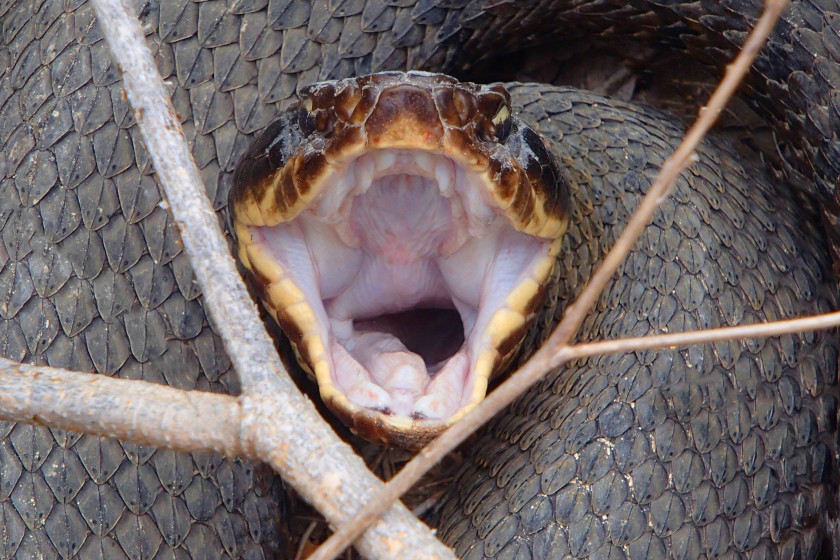
Getty Images: TayRain
This species generates a lot of confusion simply because it has more than one name; it's sometimes also referred to as a water moccasin. Some people call these snakes "pit vipers" even though that name is a blanket term that covers a variety of subspecies of venomous snake. Seriously, there are nearly 50 common or local names for this snake. It's crazy how one species of snake has garnered such a reputation. In any case, cottonmouths (Agkistrodon piscivorus) are found mostly in the southern United States. They're very common in Florida, Georgia, Alabama, Mississippi, Louisiana and parts of eastern Texas. They can also be found in the Carolinas and Virginia. Cottonmouths are also found throughout Arkansas and parts of its neighboring states.
While most of the species on this list prefer dry habitat, cottonmouths are extremely common to find around lakes, streams and rivers. If you encounter a venomous snake while kayaking or canoeing, it's likely going to be a cottonmouth. These snakes typically max out at around 2.5 feet long. Color variation can be anything from a brown or olive color to nearly black. The head is triangular, and the body is also marked with a series of dark splotches or bands. While cottonmouths are highly venomous, the good news is that the bites are rarely fatal. A man who died in 2015 was one of the most recent deadly cottonmouth bites to date. It just doesn't happen that often. And in this latest case, it seems the victim had his death expedited by alcohol and narcotics in his system. People with health conditions would also likely be wise to avoid it. We've also heard the the bites are quite painful, as if you needed another reason to avoid them!
Eastern Coral Snake
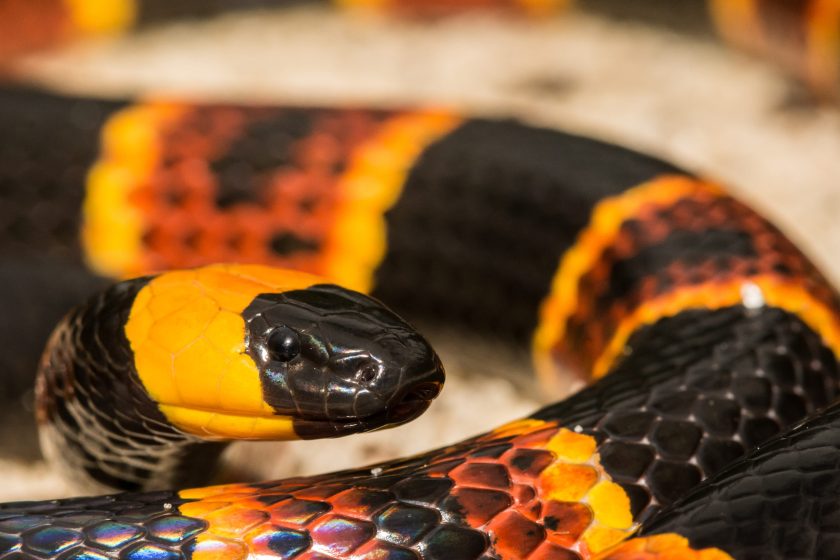
This reptile may be beautiful with its vibrant coloration. However, it is also one you will want to give a wide berth. Micrurus fulvius does not grow to large sizes. It tops out at about 30 inches. It has an extremely potent venom that can cause all sorts of health problems in humans. The primary concerns are respiratory failure and paralysis. Fatal bites are extremely rare, but you can imagine how frightening those symptoms are to someone who was just bitten. This is just one of those animals that looks much more dangerous than it actually is. Luckily, bites from the eastern coral snake are as rare as the fatalities. Still, if you are unfortunate enough to be struck, you should seek medical attention immediately. Some victims have died as much as a day later after a bite.
One thing to keep in mind with this species is the resemblance to the harmless milk snake. Both snakes have a vibrant red, black, and yellow band. There is a rhyme to remember which one is the dangerous one. "Red on black, friend of Jack. Red on yellow, kill a fellow." Remember that and observe this species from a safe distance and you should be free from all worry.
How to Avoid Snake Bites
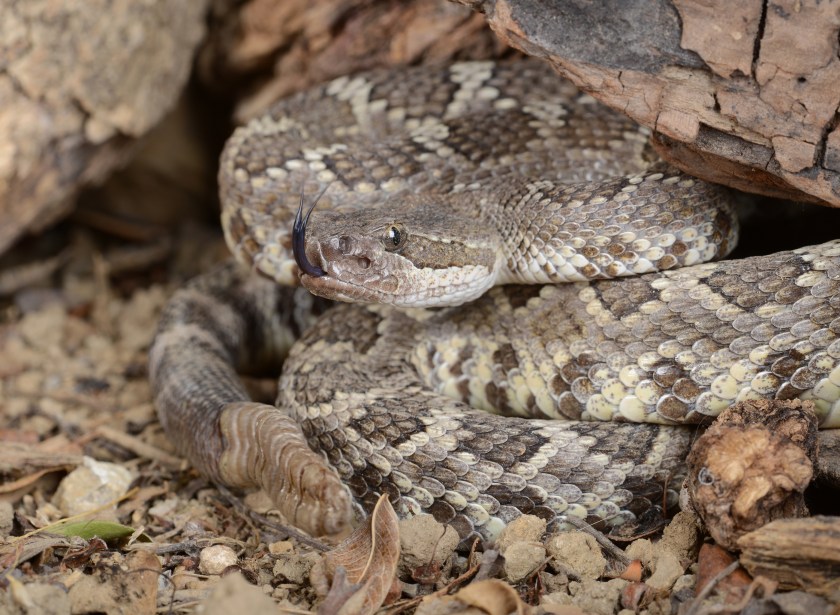
There are plenty of other venomous snake species out there. There are tons of rattler subspecies we didn't get into like the Eastern Massasauga, the prairie rattlesnake and the pygmy rattlesnake. There are also venomous species like the Texas coral snake and the eastern coral snake that strike fear in people. But bites are rare, and deadly bites are even rarer. The North American snakes we profiled here are the main ones you should be able to identify in your outdoor adventures, and need to steer clear of. Most of them are more interested in the rodents and small amphibians they prey upon than in attacking a human. Remember that there are also harmless non-venomous snakes like kingsnakes, corn snakes, milk snakes, and rat snakes that look dangerous, but are are not in any way.
No matter what species you're dealing with, we recommend leaving all snakes alone unless you've been trained in handling them. Most of the time, if you don't bother them, they won't bother you, and you can both go your separate ways. If you are unfortunate enough to be bitten by a dangerous snake, seek a hospital and antivenin treatments as soon as possible. If your outdoor activities lead you to common snake territory, a good pair of snake boots is a far less expensive option than a hospital bill. See our baby copperhead guide for more tips on how to prevent unwanted snakes from entering your yard in the first place.
If you're still having trouble sympathizing with a snake, just remember they play an important part in the ecosystem by helping control the rodent population. That's why we recommend killing one only if it is absolutely necessary.
For more outdoor content from Travis Smola, be sure to follow him on Twitter and Instagram For original videos, check out his Geocaching and Outdoors with Travis YouTube channels.
READ MORE: 8 AQUATIC SNAKES YOU NEED TO KNOW MORE ABOUT
